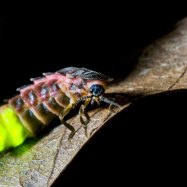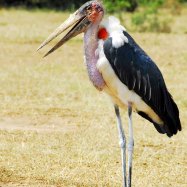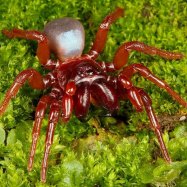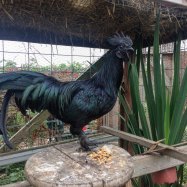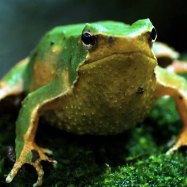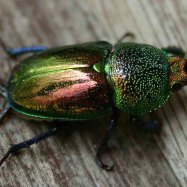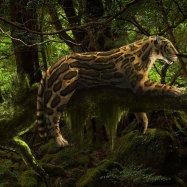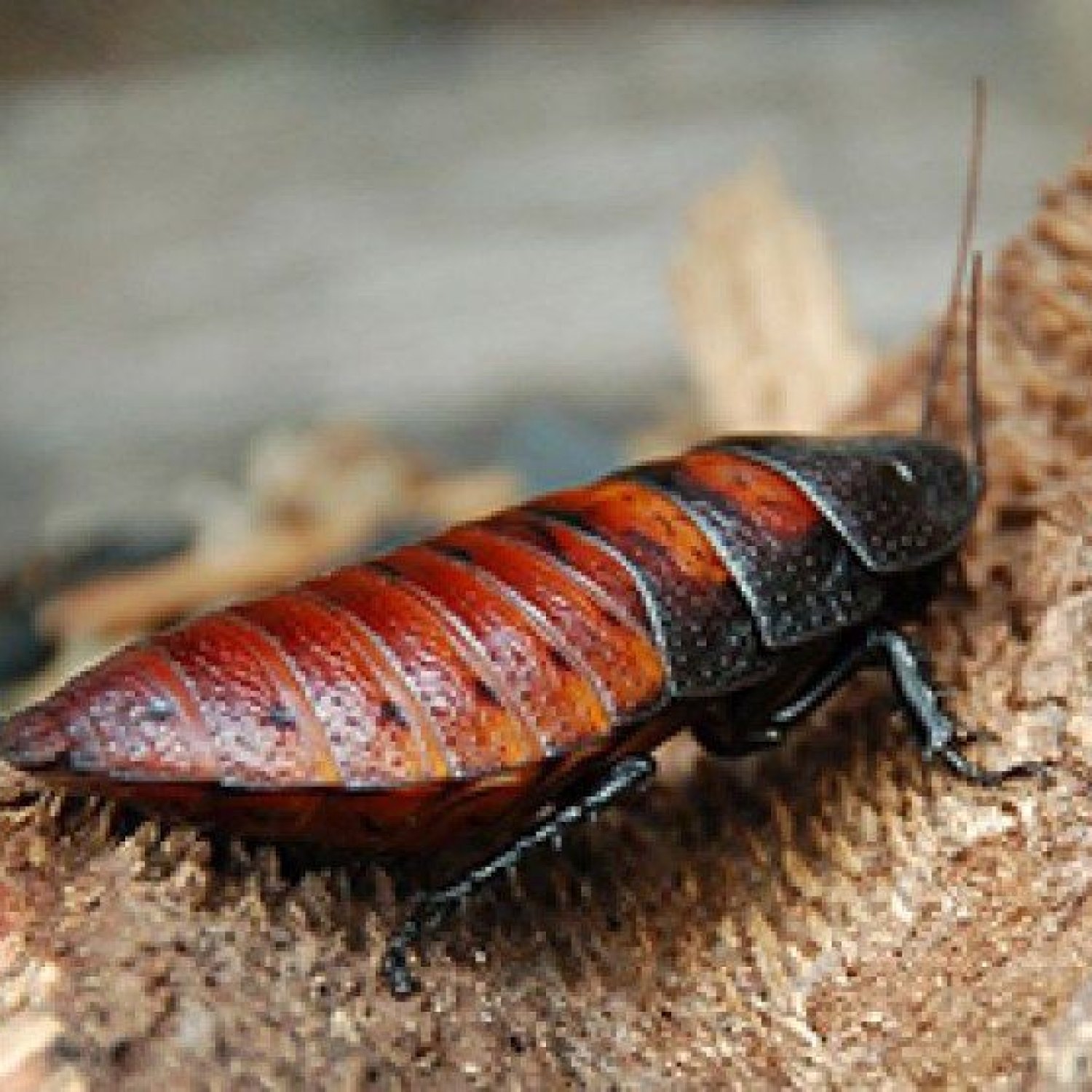
Madagascar Hissing Cockroach
5-7 centimeters
The Madagascar Hissing Cockroach, found on the island of Madagascar, is a fascinating insect with a unique ability to hiss. Measuring 5-7 cm in length, this oval and flattened creature belongs to the family Blaberidae. Discover more about these interesting creatures and their habitat in Madagascar. #MadagascarHissingCockroach #Blaberidae #IslandofMadagascar #InsectFacts
Animal Details Summary:
Common Name: Madagascar Hissing Cockroach
Kingdom: Animalia
Habitat: Tropical rainforests, caves, and rotting logs
Exploring the Fascinating World of Madagascar Hissing Cockroaches
In a world full of strange and unique creatures, the Madagascar Hissing Cockroach stands out for its ability to both creep out and fascinate people. This unusual insect, also known by its scientific name Gromphadorhina portentosa, is found exclusively on the island of Madagascar.But don't let its name or reputation fool you – this cockroach is more than just a creepy-crawly. In this article, we will dive into the fascinating features of the Madagascar Hissing Cockroach and discover why it is truly a remarkable creature in the world of insects Madagascar Hissing Cockroach.
The Kingdom of Madagascar Hissing Cockroaches
As with all living things on our planet, the Madagascar Hissing Cockroach belongs to a particular group – the Animal Kingdom. Within this kingdom, it is classified under the phylum of Arthropoda, making it a distant cousin to spiders, centipedes, and crustaceans.But what sets this insect apart is its classification under the class Insecta, which includes all insects. Under this class, the Madagascar Hissing Cockroach falls under the order Blattodea, which includes other roaches. Interestingly, this order derives its name from the Latin word blatta, which translates to "cockroach."
Exploring the Family and Habitat of Madagascar Hissing Cockroaches
Cockroaches are typically associated with dirty and unsanitary places, but that's not the case for the Madagascar Hissing Cockroach. This insect is found in the tropical rainforests of Madagascar, as well as caves and rotting logs. These habitats provide them with the warmth and moisture they need to thrive.The Madagascar Hissing Cockroach belongs to the Blaberidae family, which is known as the "giant cockroach family" due to its larger size compared to other cockroaches Mal Shi. This family also includes other hissing cockroach species found in Africa, Asia, and Australia.
Interestingly, despite their close association with humans, Madagascar Hissing Cockroaches are not considered pests. They do not feed on human food and instead, survive on fallen fruits, leaves, and other organic matter. This makes them valuable contributors to the ecosystem as detritivores, breaking down organic material and enhancing soil fertility.
The Unique Geographical Distribution of Madagascar Hissing Cockroaches
While their habitats may be limited, the Madagascar Hissing Cockroach's distribution is even smaller. These insects can only be found on the island of Madagascar, located off the coast of East Africa. This makes them endemic, meaning they are found only in one specific area on Earth.The country of origin of the Madagascar Hissing Cockroach is evident in its name, but this insect is more than just a part of the island's fauna. In fact, they play an essential role in the country's economy as a source of food for both humans and livestock.
Discovering the Physical Characteristics of Madagascar Hissing Cockroaches
One glance at a Madagascar Hissing Cockroach, and you'll immediately notice its dark brown coloration. This serves as a perfect camouflage against the forest floor, where they live and crawl.But their color is not the only remarkable thing about their physical appearance. These insects have an oval and flattened body shape, making them ideal for squeezing through tight spaces. This adaptation allows them to avoid predators and also find food in narrow crevices.
In terms of size, Madagascar Hissing Cockroaches range from 5 to 7 centimeters in length, making them one of the largest cockroach species in the world. But despite their intimidating size, these insects are harmless to humans as they do not possess any venom or harmful bacteria.
The Unique Features of Madagascar Hissing Cockroaches
What truly sets the Madagascar Hissing Cockroach apart from other roach species is their ability to hiss. When disturbed or threatened, these insects produce a loud hissing sound by expelling air from their respiratory openings. This sound can reach up to 90 decibels, making it one of the loudest insect noises in the world.But why do they hiss? This defense mechanism helps them ward off predators, such as birds and lizards, as the noise can startle or scare them away. It also serves as a means of communication between cockroach species, especially during mating season.
The Role of Madagascar Hissing Cockroaches in the World of Science
Aside from their unique features and ecological significance, Madagascar Hissing Cockroaches have also gained attention in the world of science. These insects are often used in educational and research settings, particularly in schools and universities.One reason for this is their docile nature, making them easy to handle and observe in an enclosed environment. They are also relatively easy to maintain and can survive for long periods without food or water, making them ideal for experiments.
In the field of medicine, these roaches have been utilized in research studies on antibiotics, nerve regeneration, and even as models for studying human diseases. Due to their large size, they provide a better alternative to mice and rats, typically used in laboratory experiments.
What We Can Learn from the Remarkable Madagascar Hissing Cockroach
The Madagascar Hissing Cockroach may not be the most beloved insect, but it is undoubtedly one of the most fascinating creatures on our planet. From its unique physical characteristics to its vital role in the ecosystem and contributions to the scientific community, this insect has much to teach us.Perhaps the most significant lesson we can learn from the Madagascar Hissing Cockroach is to never judge a book by its cover. While it may seem scary and repulsive at first glance, this insect is an essential part of the natural world and a testament to the incredible diversity of life on Earth.
Whether you are an insect enthusiast, a curious learner, or simply looking to expand your knowledge, the Madagascar Hissing Cockroach is undoubtedly a creature worth exploring and appreciating. So, the next time you encounter one of these hissing insects, remember that there is more to them than meets the eye.

Madagascar Hissing Cockroach
Animal Details Madagascar Hissing Cockroach - Scientific Name: Gromphadorhina portentosa
- Category: Animals M
- Scientific Name: Gromphadorhina portentosa
- Common Name: Madagascar Hissing Cockroach
- Kingdom: Animalia
- Phylum: Arthropoda
- Class: Insecta
- Order: Blattodea
- Family: Blaberidae
- Habitat: Tropical rainforests, caves, and rotting logs
- Feeding Method: Detritivore
- Geographical Distribution: Madagascar
- Country of Origin: Madagascar
- Location: Island of Madagascar
- Animal Coloration: Dark brown
- Body Shape: Oval and flattened
- Length: 5-7 centimeters

Madagascar Hissing Cockroach
- Adult Size: 5-7 centimeters
- Average Lifespan: 2-5 years
- Reproduction: Oviparous
- Reproductive Behavior: Males produce hissing sounds to attract females
- Sound or Call: Hissing sound
- Migration Pattern: Non-migratory
- Social Groups: Colonies
- Behavior: Nocturnal, primarily terrestrial
- Threats: Loss of habitat, climate change
- Conservation Status: Not evaluated
- Impact on Ecosystem: Important decomposers
- Human Use: Pets, educational purposes
- Distinctive Features: Large size, hissing sound
- Interesting Facts: Largest cockroach species
- Predator: Birds, mammals, reptiles
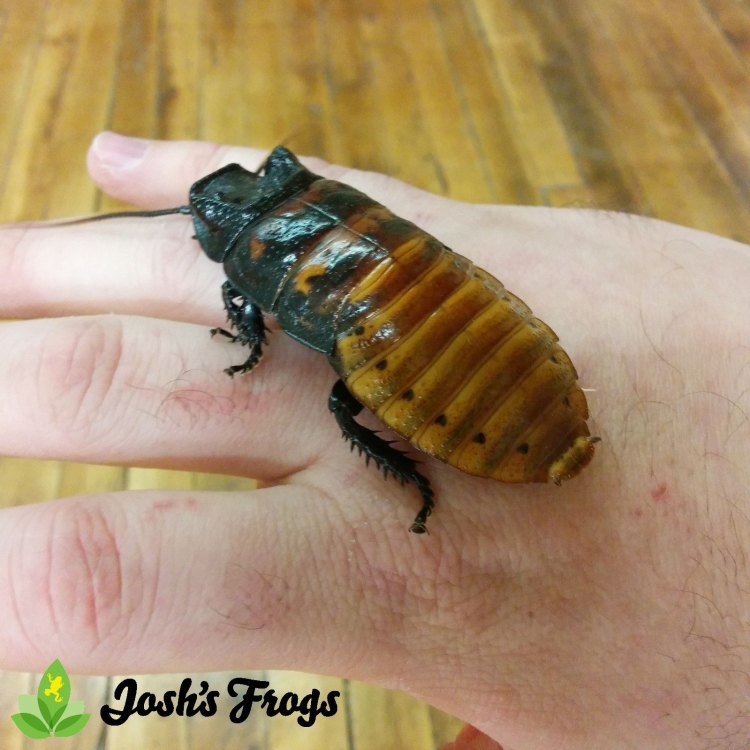
Gromphadorhina portentosa
Madagascar Hissing Cockroach: The Fascinating Insect with a Unique Talent
In the world of creepy crawlies, one insect stands out with its distinctive features and intriguing behavior - the Madagascar Hissing Cockroach. While most people cringe at the thought of cockroaches, this species is quite different from the common household pests. From its size to its reproductive behavior, the Madagascar Hissing Cockroach has a lot to offer in terms of uniqueness.Let's start with its physical appearance PeaceOfAnimals.Com. The Madagascar Hissing Cockroach, also known as Gromphadorhina portentosa, is a large insect with an adult size of 5-7 centimeters. This makes it one of the biggest species of cockroach in the world. But don't be fooled by its size, as this insect is harmless and cannot fly. It has a reddish-brown color and a thick, glossy exoskeleton that provides protection from predators.
The average lifespan of a Madagascar Hissing Cockroach is between 2 to 5 years, which is significantly longer than most other cockroach species. This is due to its ability to efficiently conserve energy and survive in harsh conditions. In the wild, these insects live in warm and humid forests, and they have adapted to thrive in such environments.
But what makes the Madagascar Hissing Cockroach truly unique is its reproductive behavior. Unlike many other insects that only reproduce through the process of mating, these cockroaches are oviparous, meaning they lay eggs Maiasaura. Females can lay up to 60 eggs at a time, which they carry in a capsule called an ootheca. These eggs take about 60 days to hatch, and the nymphs are born as mini versions of their parents, going through molting stages until they reach adulthood.
Male Madagascar Hissing Cockroaches have a fascinating way of attracting females - by producing a hissing sound. These insects have specially adapted structures called "spiracles" on the sides of their bodies, which they use to produce the hissing sound by forcefully expelling air. This sound can be heard up to a meter away and is primarily used during mating season.
Apart from their reproductive behavior, the Madagascar Hissing Cockroaches are also known for the hissing sound they make. This sound can be made by both males and females as a defense mechanism when they feel threatened. By hissing and making a commotion, they alert other cockroaches in their colony and also startle potential predators.
Speaking of colonies, the social structure of Madagascar Hissing Cockroaches is quite fascinating. They live in groups of 20-30 individuals and are primarily nocturnal, meaning they are most active at night. They are also primarily terrestrial, which means they spend most of their time on the ground, unlike other cockroach species that can climb walls and fly.
Despite their long lifespan, the Madagascar Hissing Cockroaches face multiple threats in the wild, including loss of habitat and the effects of climate change. Their natural habitats in Madagascar are rapidly decreasing due to deforestation and urbanization. Additionally, changes in the climate can also lead to the decline of their preferred living conditions, ultimately impacting their survival.
However, despite these threats, the conservation status of the Madagascar Hissing Cockroach is currently not evaluated. This is because their population is not seen to be declining at an alarming rate, and they are also widely used in various human activities.
One of the most common uses of Madagascar Hissing Cockroaches is as pets. Due to their large size and unique features, they have become popular among insect enthusiasts. However, these insects need specialized care and a suitable habitat to thrive, making them more suitable for experienced pet owners.
Apart from being pets, Madagascar Hissing Cockroaches also have an essential role in educational purposes. Since they are easily available and not dangerous, many schools and educational institutions use them for scientific experiments and activities related to entomology. These insects are also easy to handle and can be safely brought into classrooms for educational purposes, giving students a hands-on experience with these fascinating insects.
But perhaps the most vital role of the Madagascar Hissing Cockroach is its contribution to the ecosystem. As scavengers, these insects play a crucial role in decomposing and recycling organic matter, which is essential in maintaining the balance of the ecosystem. In their natural habitat, they feed on decaying plant and animal matter, making them an essential part of the nutrient cycle.
Despite their crucial role in the ecosystem, Madagascar Hissing Cockroaches are often seen as pests and are killed if found in homes or other human-inhabited areas. However, it is essential to understand that these insects are harmless and should not be treated as pests. They do not carry diseases and are not a threat to human health. In fact, they offer many benefits, such as acting as natural pest controllers by competing with other cockroach species for resources.
In the wild, Madagascar Hissing Cockroaches have natural predators, including birds, mammals, and reptiles. However, due to their large size and the hissing sound they make, they are not the most appealing prey for predators. Instead, they have developed a unique ability to survive and thrive in harsh conditions, making them one of the most resilient insect species.
In conclusion, the Madagascar Hissing Cockroach is a fascinating insect with many unique features and abilities. Despite being labeled as pests, these insects are harmless and hold an essential role in the ecosystem. By understanding and appreciating their role, we can work towards conserving their natural habitats and appreciate their incredible talents. So the next time you come across a hissing sound in the forest, don't be afraid - it may just be a group of Madagascar Hissing Cockroaches communicating with each other.
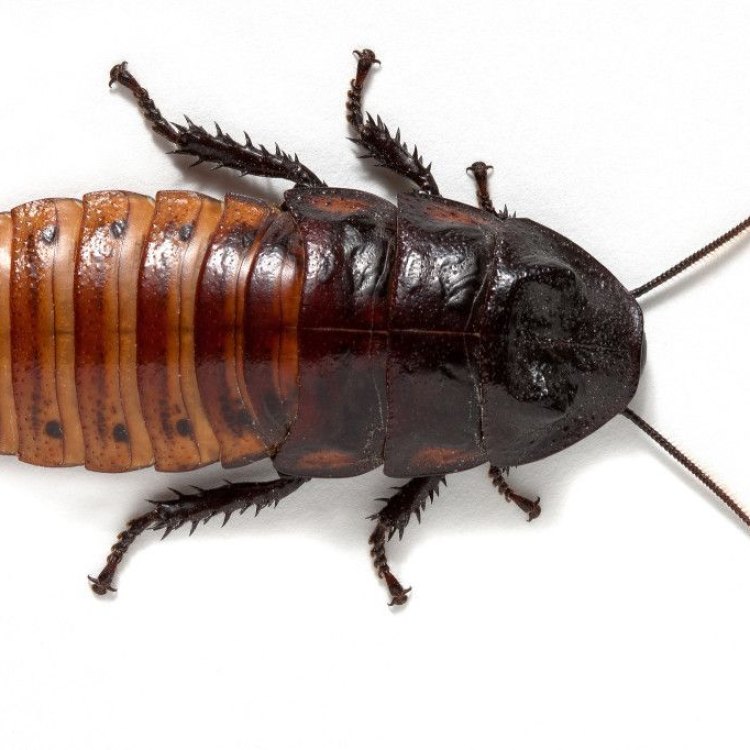
Exploring the Fascinating World of Madagascar Hissing Cockroaches
Disclaimer: The content provided is for informational purposes only. We cannot guarantee the accuracy of the information on this page 100%. All information provided here may change without prior notice.



